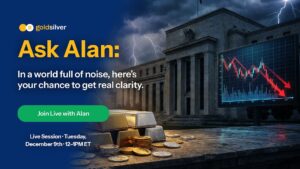Most cryptocurrencies aren’t decentralized. Not even close.
This surprises most people exploring digital assets, who assume decentralization is crypto’s defining trait — the core value that makes it compelling. But as Alan Hibbard has shown through years of research into crypto, the reality looks nothing like that. Most cryptocurrencies today are simply distributed versions of centralized systems.
Here’s why that matters for investors.
What Is the Blockchain Trilemma?
The blockchain trilemma is a concept introduced by Ethereum’s Vitalik Buterin. It states that a blockchain can optimize for only two of the following three at the same time:
- Decentralization — no central authority, equal participation
- Security — strong protection against attacks
- Scalability — ability to process lots of transactions quickly
The trilemma suggests you can’t maximize all three without sacrificing one. For example:
- Bitcoin prioritizes security + decentralization, but isn’t highly scalable.
- Many modern crypto projects choose security + scalability, but give up decentralization.
- Others try to maximize scalability + decentralization, but weaken security.
This is why claims of “solving” the trilemma are usually misleading — trade-offs always exist. And more importantly, most modern crypto projects have quietly chosen to sacrifice decentralization in order to achieve the scalability needed to compete.
The Myth of “Solved Decentralization”
Many crypto projects claim to have cracked the blockchain trilemma — offering security, scalability, and decentralization all at once.
But as Alan’s analysis of dozens of networks reveals, most of these “solutions” simply redefine decentralization rather than truly achieving it.
They haven’t rewired the architecture. They’ve just rebranded it.
What Decentralization Really Means
In its truest form, decentralization means rules without rulers — a system where no one has special permissions, privileged access, or override power. Everyone operates on equal footing.
You see this clearly in:
- Gold — anyone can discover it, mine it, refine it, or own it. Its governance is built into nature itself.
- Bitcoin — no foundation, no CEO, no board. Network changes require broad consensus, not elite approval.
This is decentralization as Alan defines it: systems governed by physics and math, not committees.

Distributed Systems ≠ Decentralized Systems
Many crypto networks market themselves as decentralized simply because they run across multiple nodes. But structure doesn’t equal sovereignty.
Most give special validator rights to a small group — whether it’s stakers, insiders, early investors, or a foundation. That’s not decentralization; that’s distributed centralization.
Think of the Federal Reserve.
Twelve regional banks spread throughout the country? That’s distributed. But ultimately, power flows upward to a centralized authority.
Many crypto projects follow the same pattern — distributed infrastructure, centralized control.
The Problem With “We’ll Decentralize Later”
A common promise in crypto is, “We’ll become more decentralized over time.”
But as Alan points out, decentralizing actually becomes more difficult as a network grows. To truly decentralize later, a project would need to voluntarily give up scalability advantages, insider controls, privileged validator roles — and often revenue itself. Few venture-backed teams are willing to make those sacrifices once they’ve achieved product-market fit.
So “decentralize later” almost always means never.
Why This Really Matters to Investors
For long-term investors — especially those protecting wealth in an unstable financial system — the difference between “distributed” and “decentralized” is not academic.
It’s a risk model. Centrally controlled assets can:
- be halted
- be censored
- be restructured
- be manipulated
- collapse through governance failures
- be captured by regulators
Assets governed by physics (gold) and math (Bitcoin) avoid these tail risks entirely.
That’s why Alan often emphasizes these assets as true crypto decentralization benchmarks — systems where no privileged group can suddenly change the rules or seize control.
In an era of political volatility, inflation pressure, and technological uncertainty, that distinction matters more than ever.
Learn More: Ask Alan Webinar (December 9th, 2025)
Alan will be expanding on crypto decentralization — along with gold, Bitcoin, and macro strategy — in an upcoming live webinar. This is your chance to ask questions directly and understand how he evaluates true decentralization versus marketing claims.
People Also Ask
What does crypto decentralization actually mean?
True crypto decentralization means a system operates with rules without rulers—no one has special permissions, privileged access, or override power. Bitcoin exemplifies this: it has no CEO, foundation, or board, and network changes require broad consensus rather than elite approval. Most cryptocurrencies claim decentralization but actually maintain centralized control through special validator rights or insider privileges.
What is the blockchain trilemma in simple terms?
The blockchain trilemma states that blockchains can only optimize for two of three qualities: decentralization, security, and scalability. Bitcoin prioritizes decentralization and security but sacrifices scalability, while most modern crypto projects choose security and scalability but give up true decentralization. This is why claims of “solving” the trilemma are typically misleading — trade-offs always exist.
Are most cryptocurrencies actually decentralized?
No, most cryptocurrencies aren’t truly decentralized despite marketing claims. They run on distributed systems (multiple nodes) but maintain centralized control through foundations, special validator rights, or insider privileges. As Alan Hibbard’s research shows, the difference between distributed infrastructure and decentralized governance is crucial for investors to understand.
What’s the difference between distributed and decentralized crypto?
Distributed means a network runs across multiple nodes or locations, while decentralized means no single group has control or special privileges. Many crypto projects distribute their networks across nodes but still concentrate real control—much like the Federal Reserve, which spreads regional banks across the country yet retains a central authority. True decentralization, as we see with Bitcoin or gold, relies on math or physics to set the rules instead of committees.
Which cryptocurrencies are truly decentralized?
Bitcoin stands out as genuinely decentralized, with no foundation, CEO, or special privileges — network changes require broad consensus. Gold, while not a cryptocurrency, sets the ultimate decentralization benchmark because physics alone governs it.








